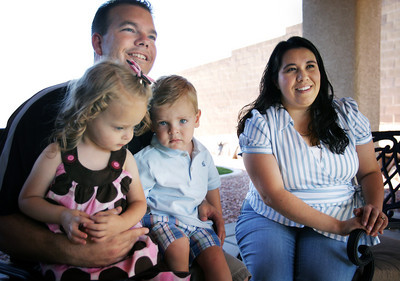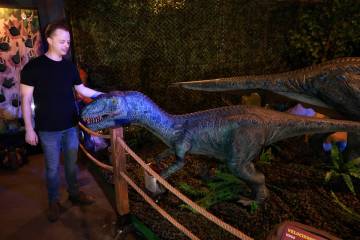Couple starts family through ’embryo adoption’
Matthew and Jenna are 21/2-year-old fraternal twins. They share cute round faces, wide, inquisitive eyes that don't miss a thing and cheekbones a model would die for.
They also share a history that would make them the talk of the playground if anybody their age remotely cared: They were adopted nine months before they were born, in the form of embryos created and frozen six years before that.
But, for Jim and Barbara Seebock, Matthew and Jenna are simply the answer to a prayer, even if the method of conception they chose -- "embryo adoption" -- represents yet another twist on what used to be the straightforward business of conception.
The Seebocks decided a few years ago to start a family. But, Jim says, "I can't have kids, and Barbara can."
The Seebocks could have used donor sperm to fertilize Barbara's eggs. However, the couple decided that conception would involve either both of them or neither of them.
They began to explore adoption. But, while listening to a Christian radio station, the couple learned of the Snowflakes Embryo Adoption Program of Nightlight Christian Adoptions, a Fullerton, Calif., adoption agency.
Megan Corcoran, Snowflakes progam coordinator, said the program involves placing with prospective parents embryos that are created, but not used, by other couples who have undergone in vitro fertilization procedures.
In standard in vitro fertilization, eggs taken from a woman and sperm taken from a man are combined outside the womb and in the laboratory. Resulting embryos then are implanted into the woman, who carries one or more of them to full term and gives birth.
But in vitro fertilization procedures generally create more embryos than are needed for a pregnancy. A couple's additional embryos can be frozen to await the day when they're used to create another pregnancy, are discarded, or used for medical research.
However, some couples have qualms with the latter two options. For them, Corcoran says, "life is a precious thing," and disposing of embryos or using them in medical research is "against what we believed was right. We believe an embryo is a life and needs to be protected and given a chance to be born."
That prompted the creation of the Snowflakes program. Legally speaking, transferring ownership of a frozen embryo from one couple to another is a mere property transfer. But, for Snowflakes, the transfer is treated as an adoption, involving the same procedures -- including background checks, criminal screenings and comprehensive medical surveys -- that would be required when a family adopts a child.
The actual in vitro fertilization treatments are done by the recipients' own doctor in the couple's local clinic. Nightlight, meanwhile, handles the necessary paperwork and investigations and acts as a liaison between donor and recipient.
Corcoran says donors are notified of the result. From then on, the donor and recipient families may stay in touch to whatever degree they wish.
The Snowflakes program began in 1997, and the first baby was born at the end of 1998, Corcoran said. To date, more than 200 children have been born through it while, on the other side of the equation, about 393 families have placed embryos into the program.
Unlike traditional adoption, embryo adoption enabled the Seebocks to experience a traditional pregnancy. "We (got) to control prenatal development," Jim says, and the couple shared "the excitement building up to the birth of a baby."
But while the science is straightforward, the philosophical -- and, maybe, the religious -- underpinnings of embryo adoption are trickier. Most obviously: It begins with the premise that an embryo is a life.
"We operate from the standpoint an embryo is a life and deserves to be given an opportunity whether or not it's going to turn into a baby," Corcoran says.
"We call it adoption," she adds, even if clients are "adopting a baby nine months before they're born. It needs nothing else in the world except what an already-born baby needs, which is a place to live."
"I have heard people who don't feel comfortable calling it an 'adoption,' " Corcoran concedes. "And, actually, someone who is very heavily involved in adoption said, 'We can't call this adoption because it takes away from adopting of a child who is already born.'
"Legally, it is not an adoption. Socially, I think it's more adoption than not an adoption, because you are going to grow and raise a child that's not genetically related to you, that you don't have any genetic part of, and that some other family chose you to parent. So it's not like sperm and egg donation."
So it's just about a semantic concern that stems from a religious conviction? It would, Corcoran answers, be "very hard for me to say it's a religious standpoint."
"I feel it is a tiny, tiny human. What else could it be?" Corcoran says. "I know some people say it's a cluster of cells. Well, you can't have a baby without it, and you don't add anything to it in order to create a baby, so it's a baby at the very tiniest form, and if you discard it, you'll never get that baby again."
"So, to me, it doesn't feel like a religious conviction to say it's a life," Corcoran says. "It just is."
Arthur Caplan, a professor of bioethics at the University of Pennsylvania, views this use of the word "adopt" as "an important point," because "what we're used to is the adoption of a child."
"When you use the phrase 'embryo adoption,' it is intentional, because they want people to view embryos as children," Caplan says. "The groups affiliated with embryo adoption are very much in the pro-life, right-to-life mode, and they're trying to upgrade the status of the embryo, not talking about 'adopting a possible child' or 'taking custody of an embryo.' They're using language for a deliberately political point."
Caplan adds that, as a procedure, he has no problem with embryo adoption. "I don't have any religious view about it one way or another, although I'm not in the camp that sees embryos as a person."
He does predict, however, that it will be an option relatively few couples choose.
Couples who undergo fertility procedures typically are motivated by the desire to have "a genetic or biological connection to their baby," Caplan says. "You wouldn't be spending tens of thousands of dollars if you were just willing to get a baby that wasn't even related to mother or dad or both."
Such couples "want very much to have a biological tie to their child," he says. "Embryo adoption doesn't achieve that."
Embryo adoption also remains subject to the uncertainties of in vitro fertilization. Not every embryo that is implanted results in pregnancy. And, Caplan says, frozen embryos provided by couples who are, themselves, undergoing infertility treatments are less than ideal.
"You're using embryos from couples that have fertility problems," Caplan notes. "If you want to try to have a child, that's not the place to go. You want someone to donate an embryo to you who you knew was fertile."
"If you're going to spend $10,000 a cycle to implant embryos, you want the best chance to have a child," he says.
Corcoran said Snowflakes has received federal grant money over the past several years to promote embryo adoption "in general," with none of the money being used for Snowflakes' marketing or administration.
Caplan says he has been a "staunch critic" of that. While he has no problem with couples choosing the procedure, "I don't think it has to be government-subsidized," Caplan says.
Caplan also foresees a practical issue in the future, when children adopted as embryos choose to seek out their genetic parents.
Many adopted children have gone to court "to find out who their biological parents are, and win those cases in court," he says. "I can tell you with some certainty that's going to happen to some people who adopt embryos. Their kids are going to want to know, 'Who are my quote-unquote real parents.' "
At some point, Jim Seebock says he and his wife will tell Matthew and Jenna that "they're adopted. As they get to understand it, we will explain it."
And, Barbara says, she and Jim will explain "how mommy carried you."
But, for now, such details don't matter.
"We don't go around saying, 'You know, this is our embryo-adopted baby," Jim says. "We just say, 'This is Matthew and Jenna.' "
The twins may even have brothers or sisters by then. The Seebocks still have 10 embryos in storage, all from the same donor, that they can use to expand their family.
Statistically, Jim notes, those 10 embryos could result in two more kids, both of whom would be genetic siblings of Matthew and Jenna.
So?
Barbara smiles and laughs at the unspoken question while, in the backyard, Matthew and Jenna try mightily to avoid posing for a photo.
Maybe, Barbara answers. But not quite yet.
Contact reporter John Przybys at jprzybys@reviewjournal.com or 702-383-0280.























